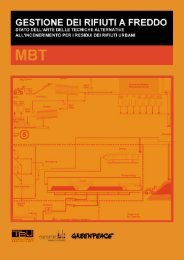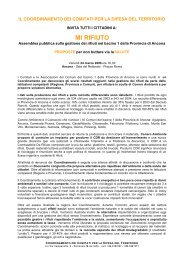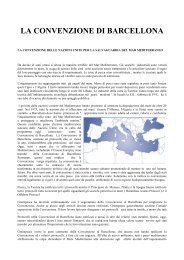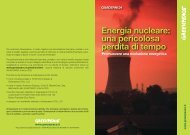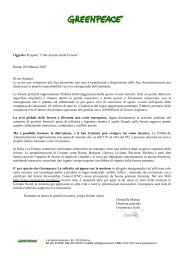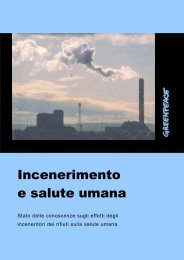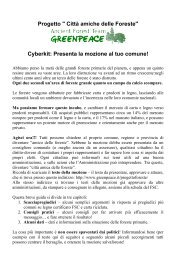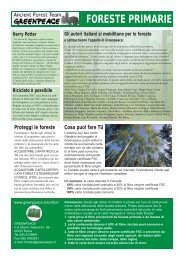Zero Waste by Robin Murray, Greenpeace Environmental Trust 2002
Zero Waste by Robin Murray, Greenpeace Environmental Trust 2002
Zero Waste by Robin Murray, Greenpeace Environmental Trust 2002
Create successful ePaper yourself
Turn your PDF publications into a flip-book with our unique Google optimized e-Paper software.
• minimising costs, not advancing a strategy. The scheme<br />
was established not to contribute to the costs of<br />
conversion <strong>by</strong> funding kerbside collection schemes of<br />
domestic packaging as in Germany, but to minimise<br />
the costs of complying with the EU Directive. This has<br />
meant that the targets up to now have been loose, and<br />
have been met largely from industrial and commercial<br />
waste and more recently from expanding bring banks<br />
for domestic waste. As the Chief Executive of VALPAK<br />
put it, ‘There has been an excess of supply over<br />
demand, so therefore the targets, you could argue,<br />
have not been tight enough. They should have been set<br />
much tighter in retrospect.’ 70 The scheme has been<br />
successful in its purpose of cost minimisation. UK<br />
packagers are contributing less than one-tenth as much<br />
as their German counterparts. But Britain’s packaging<br />
recycling has only increased modestly since the scheme<br />
was started (see Table 6).<br />
Table 6 Estimated packaging recycling rates in the UK<br />
1998-2006(%)<br />
1998 1999 2000 2001 2006*<br />
Aluminium 13 14 15 18** 50<br />
Steel 25 30 32<br />
Glass 23 27 33 70<br />
Paper 47 47 49 60<br />
Plastic 8 12 12 18** 20<br />
Wood 44 N/A.<br />
All recycling 29 33 36 45 60<br />
EfW 4 5 5 -<br />
All re c o v e ry 33 38 42 50** 60<br />
S o u rce: DEFRA Consultation Paper on Packaging, Sept 2001<br />
* amended option targets from EU ** minimum target<br />
Britain’s packaging recycling rate is less than half that<br />
of Germany and there is doubt whether it will meet its<br />
legal recovery target <strong>by</strong> the end of 2001.<br />
• sidelining local authorities. The scheme was set up<br />
explicitly to marginalise local authorities. Money was<br />
paid into the scheme <strong>by</strong> the packaging-related firms in<br />
the form of the purchase of packaging recovery notes,<br />
a marketable certificate issued <strong>by</strong> processing firms to<br />
say that they had received secondary materials for<br />
recycling. This was in effect a quasi-money, and<br />
processors were given the profits of the mint. They did<br />
not have to give these notes to local authorities that<br />
supplied them with materials, only to industry bodies<br />
representing the packagers if they supplied recyclable<br />
materials. The result is that economic power in this<br />
quasi-market has been placed in the hands of<br />
processors and the ‘obligated’ packaging firms, 71 and<br />
few of the contributions that have been paid out have<br />
gone to local authorities. Much of the profit has<br />
remained as a windfall to processors who were already<br />
receiving substantial flows of recyclate.<br />
The third scheme, the Private Finance Initiative (PFI), has<br />
been even more problematic. As studies undertaken for<br />
the DTI pointed out, the construction of large waste<br />
facilities, particularly incinerators, was in any case almost<br />
all undertaken, owned and financed <strong>by</strong> the private sector,<br />
and underwritten <strong>by</strong> a local authority-guaranteed gate fee.<br />
It was difficult therefore to argue that there could be an<br />
extra productivity advantage from private provision using<br />
private finance when this was already the norm in the<br />
industry. Until September 2000, the seven PFI schemes<br />
that had been approved provided large subsidies for<br />
incinerator-led packages of provision, whose impact was<br />
not to encourage private finance into formally publicly<br />
financed projects, but to introduce a bias towards capitalintensive<br />
waste plant, contrary to the knowledge-intensive<br />
needs of recycling.<br />
All three schemes have similar characteristics. They are<br />
innovative experiments in privatising the functions of<br />
public finance, they have (with the partial exception of<br />
PFI) kept down the size of the public sector budget, and<br />
they have each led to a serious squandering of an<br />
106<br />
<strong>Zero</strong> <strong>Waste</strong><br />
107



